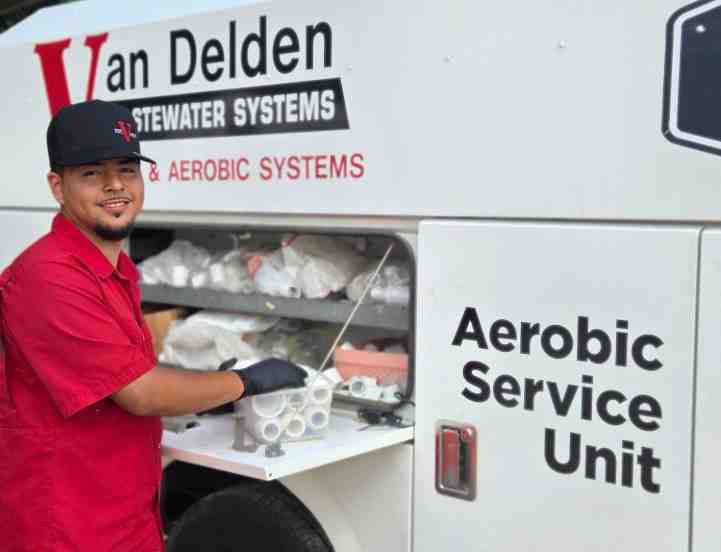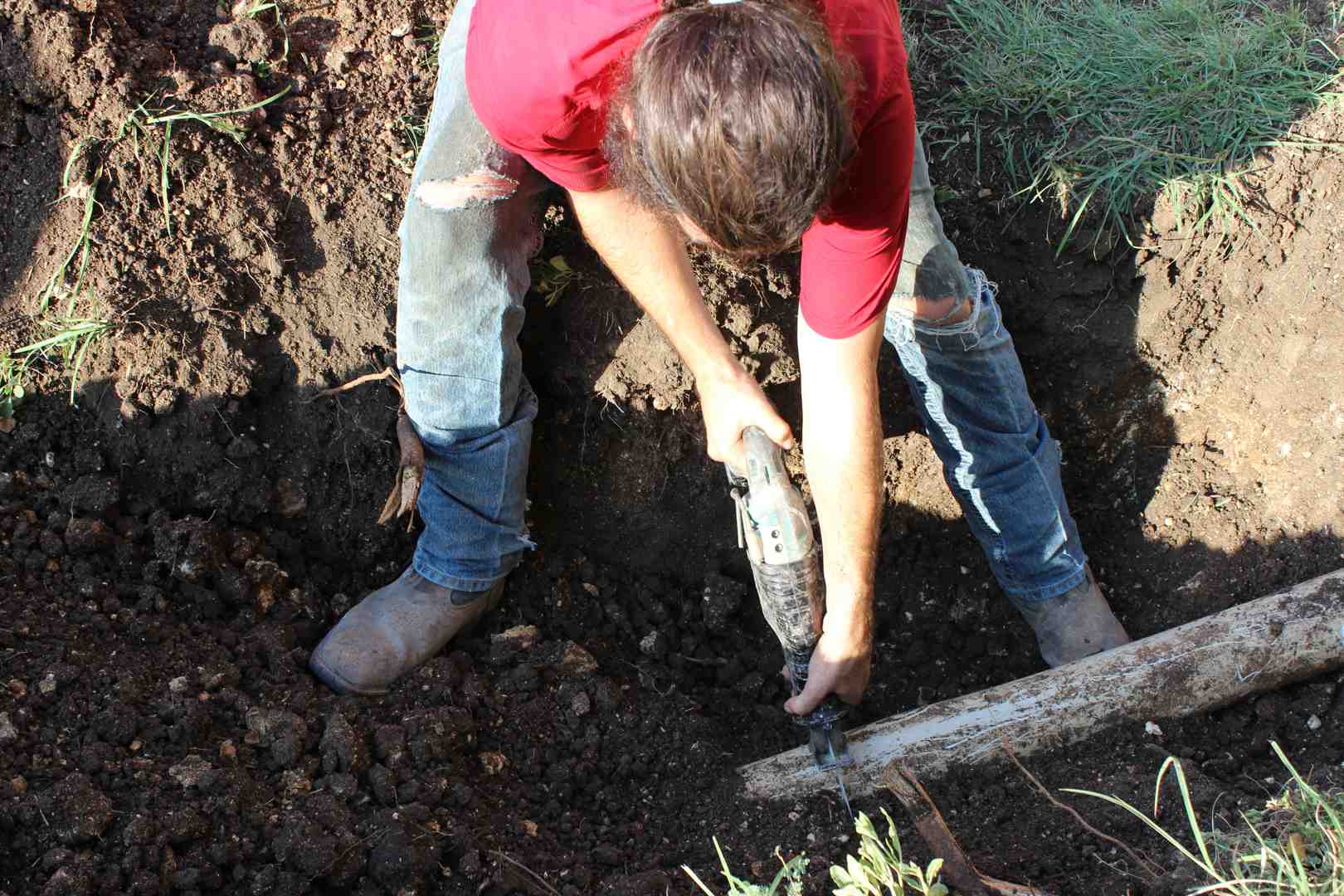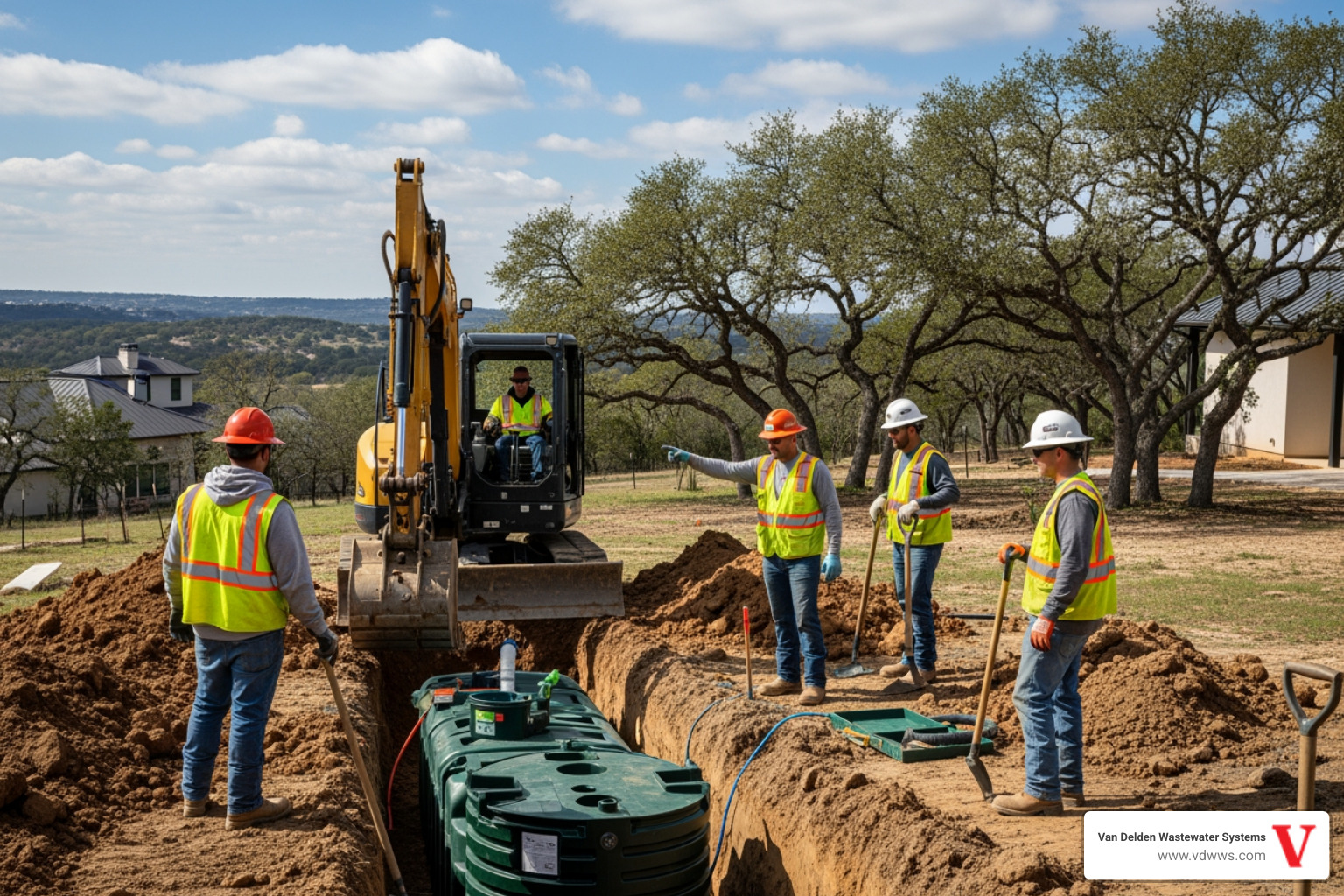That Blaring Alarm and What It Means for Your Home
Aerobic system repair becomes a pressing concern when the alarm in your yard starts blaring. If you have an aerobic system, you need to know what to do when its alarm activates.
Quick Actions When Your Aerobic System Alarm Activates:
- Don't panic - An activated alarm signals a need for attention, not necessarily an emergency.
- Check the power - Ensure the system's power switch is on and the breaker hasn't tripped.
- Reduce water usage - Immediately limit showers, laundry, and dishwashing.
- Call a licensed provider - Prompt professional attention prevents bigger problems.
- Perform a visual inspection - Look for obvious issues like standing water or damaged spray heads.
Common problems that trigger alarms include power failures, pump issues, low air pressure, faulty timers, and clogged spray heads. Fortunately, many of these have simple fixes when caught early.
Your aerobic septic system is a sophisticated backyard wastewater treatment plant. It uses oxygen-loving microorganisms to break down waste more efficiently than conventional systems. This advanced treatment produces cleaner water but involves more components that can malfunction.
Understanding your system helps you respond appropriately. Regular maintenance checks every four months are mandated by TCEQ and are your best defense against costly emergency repairs.
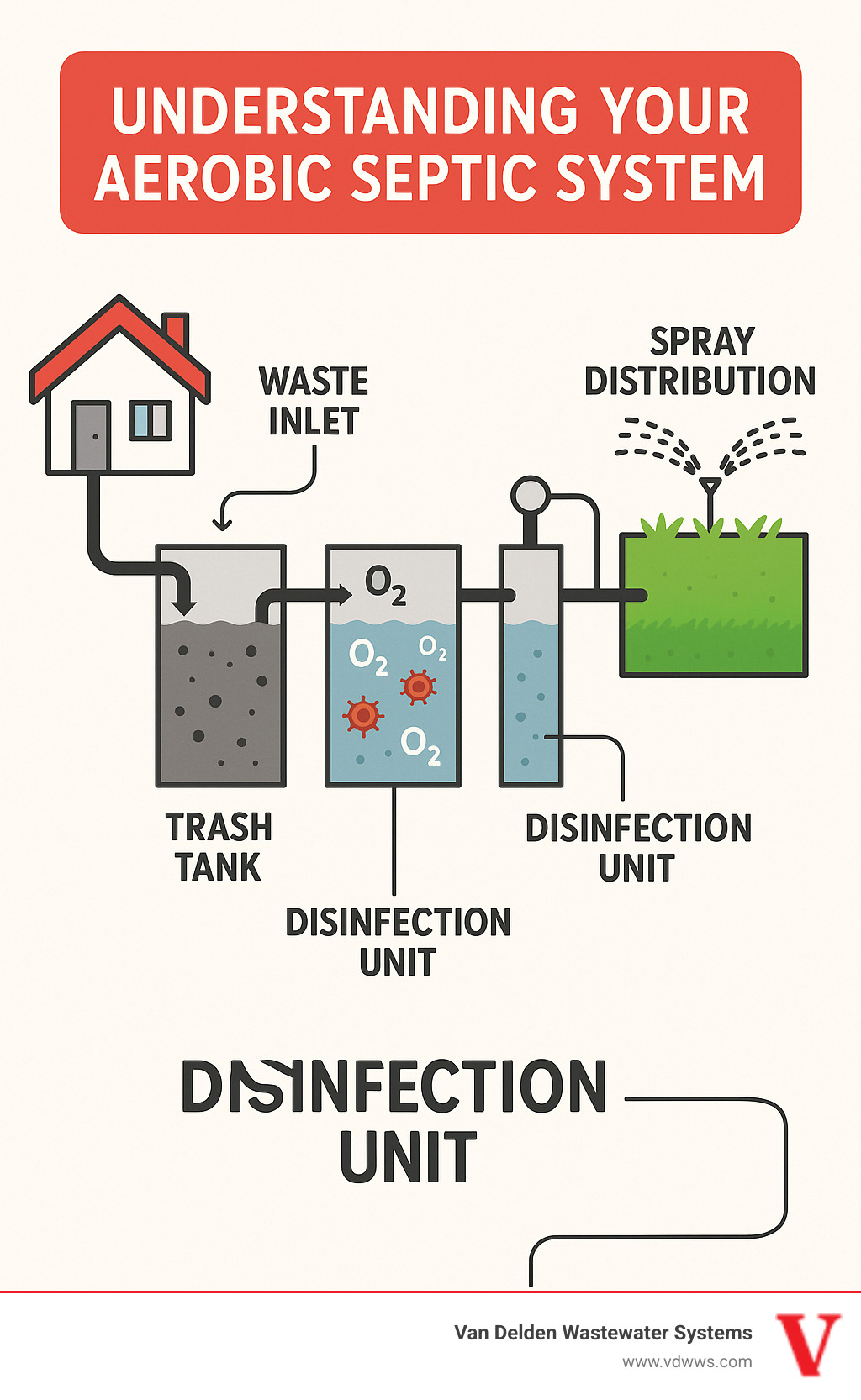
Understanding Your Aerobic Septic System
An aerobic septic system is a sophisticated wastewater treatment plant in your backyard, used by millions of U.S. households. It doesn't just store waste; it actively treats it to create cleaner water that's safer for your property and the environment.
How Aerobic Systems Differ from Conventional Septic
The secret ingredient is oxygen. Conventional septic systems use anaerobic bacteria (which work without oxygen) to slowly break down waste, resulting in lower-quality effluent that requires a large drainfield. Your aerobic system pumps air into the wastewater, creating a thriving environment for aerobic bacteria that break down waste much faster and more thoroughly.
This improved treatment produces cleaner water and requires less space for a drainfield, making aerobic systems ideal for properties with poor soil, high water tables, or smaller lots.
| Feature | Aerobic Systems | Conventional Systems |
|---|---|---|
| Treatment Process | Uses oxygen to support aerobic bacteria for highly efficient breakdown | Relies on anaerobic bacteria in an oxygen-deprived environment |
| Effluent Quality | Higher quality, cleaner effluent, often disinfected | Lower quality effluent, requires more soil treatment |
| Maintenance Needs | More frequent professional inspections (every 4 months) and mechanical component checks | Less frequent professional inspections (every 3 years) and pumping |
| Cost | Higher initial installation cost due to mechanical components | Lower initial installation cost |
| Environmental Suitability | Ideal for challenging sites (poor soil, high water table, small lots); better for sensitive environments | Best for sites with good soil and ample space for a large drainfield |
For more details, see How Aerobic Septic Systems Work, 4 Advantages of Aerobic Septic Systems, and our guide: Aerobic Systems Decoded.
The Critical Components and Their Common Failures
Understanding what each part does makes aerobic system repair less mysterious. Your system is a team of components working together.

- Trash Tank: Receives all household wastewater, allowing solids to settle. If not pumped regularly, it can overwhelm the system.
- Aerobic Treatment Unit (ATU): This is the core of the system. The aerator pump bubbles air through the wastewater, feeding the aerobic bacteria. A failed pump or low air pressure kills these bacteria, leading to poor treatment, odors, and alarms.
- Disinfection Chamber: Chlorine tablets kill remaining harmful bacteria. Malfunctioning timers and photocells or running out of tablets can release untreated water. Learn more about Why Aerobic System Timer Stops Working.
- Pump Tank: Collects treated water before it's sent to the drainfield. A failed submersible pump causes backups and triggers alarms.
- Floats: These monitor water levels and control the pumps. If they stick or fail, they can cause flooding or backups.
- Spray Heads/Drip Lines: Distribute the clean water. They are prone to clogging from debris or mineral buildup, creating soggy spots in your yard. See our guide on Why Aerobic System Sprinklers Get Clogged.
When one component fails, it affects the others. This is why regular maintenance and prompt aerobic system repair are crucial.
Signs of Trouble: Diagnosing Common Aerobic System Problems
Recognizing your system's distress signals can save you from costly emergency aerobic system repair. Your system often gives subtle warnings before the alarm sounds.
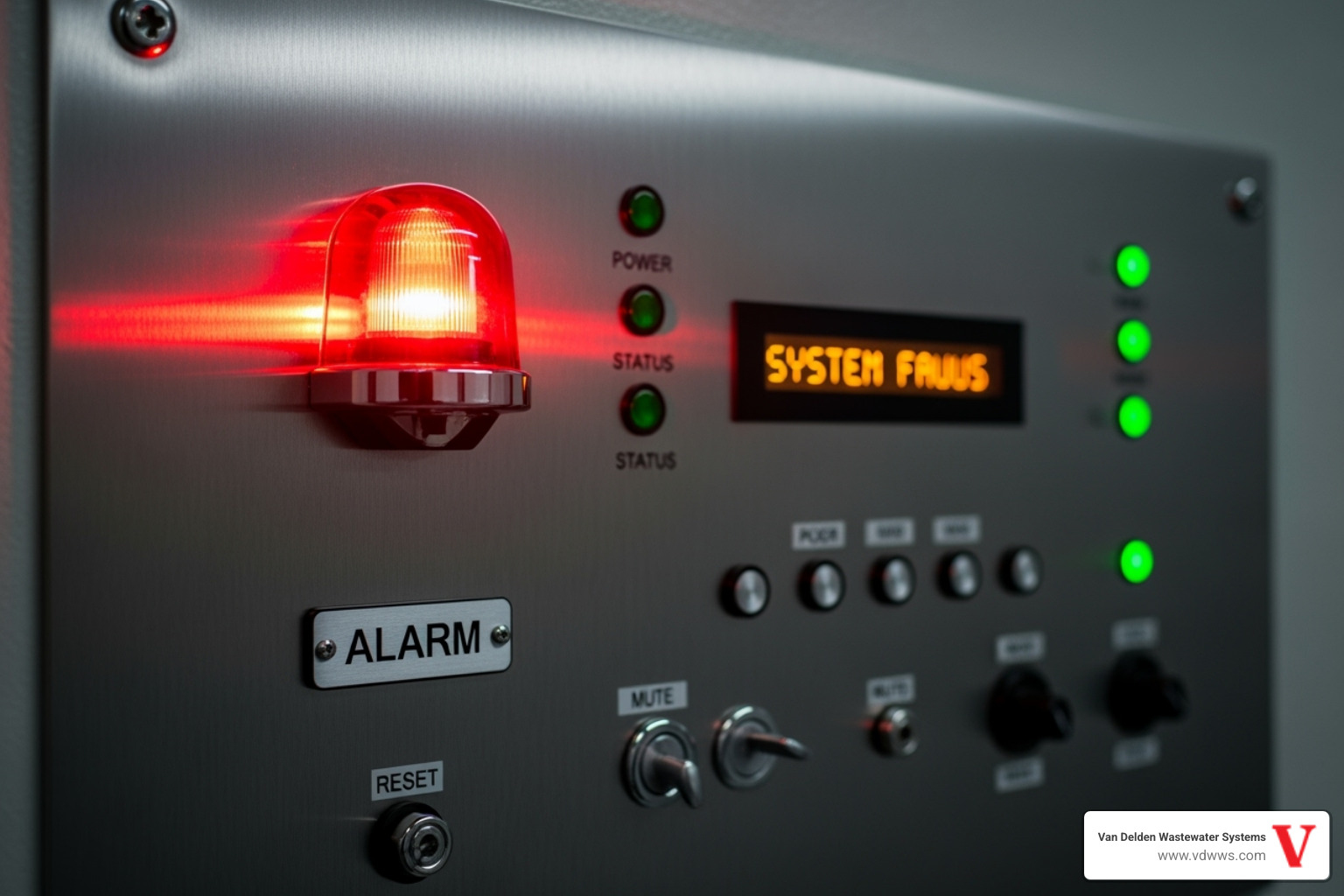
Key warning signs include:
- Foul Odors: A sewage smell near your system means the aerobic bacteria aren't working properly. If you're dealing with this, see our guide: Help My Aerobic System Smells.
- Slow Drains & Gurgling Sounds: These often point to a backup caused by a pump failure or clogged lines.
- Wet Spots: Standing water near your tank or drainfield (when it hasn't rained) indicates a dispersal problem.
- Unusually Green Grass: Lush, dark green grass over your drainfield suggests untreated wastewater is surfacing.
Catching these Common Aerobic System Problems early is key.
What to Do When Your Aerobic System Alarm Activates
When the alarm blares, don't panic. It demands attention but isn't always a disaster.
- Silence the Alarm: Press the silence button on the alarm panel. The alarm light will likely stay on to remind you the problem still exists.
- Check Power: Go to your electrical panel and reset the system's breaker if it has tripped. Ensure the power switch on the system itself is on.
- Reduce Water Usage: This is critical. Limit showers, laundry, and dishwashing to reduce stress on the system and prevent backups.
- Visual Inspection: Check if spray heads are working and look for standing water around the tanks. Do not open any tanks or touch electrical components.
- Call a Professional: This is the most important step. Contact a TCEQ Licensed Maintenance Provider promptly. For more guidance, see our resource on Aerobic System Alarm Activation.
DIY Fixes vs. Professional Aerobic System Repair
Knowing the line between a DIY task and a professional job is crucial for aerobic system repair.
Safe DIY Tasks:
- Resetting a tripped breaker.
- Silencing the alarm.
- Reducing household water usage.
- Checking and refilling chlorine tablets (use only septic-safe calcium hypochlorite tablets, never pool chlorine).
- Gently cleaning visible debris from sprinkler heads.
When to Call a Professional:
- Any electrical issue beyond a breaker reset.
- Suspected pump failures (aerator or submersible).
- Clogged lines that require professional equipment.
- Persistent alarms or foul odors.
- Wet spots in the yard, indicating a drainfield problem.
When in doubt, call a professional. To see what a service call involves, read What to Expect During a Van Delden Septic System Service Call.
Proactive Care: The Ultimate Guide to Aerobic System Maintenance
Most aerobic system repair issues are preventable with simple, daily habits. Your system is home to millions of bacteria that need the right environment to work: not too much water, no harsh chemicals, and no indigestible waste. Protecting these conditions protects your investment.
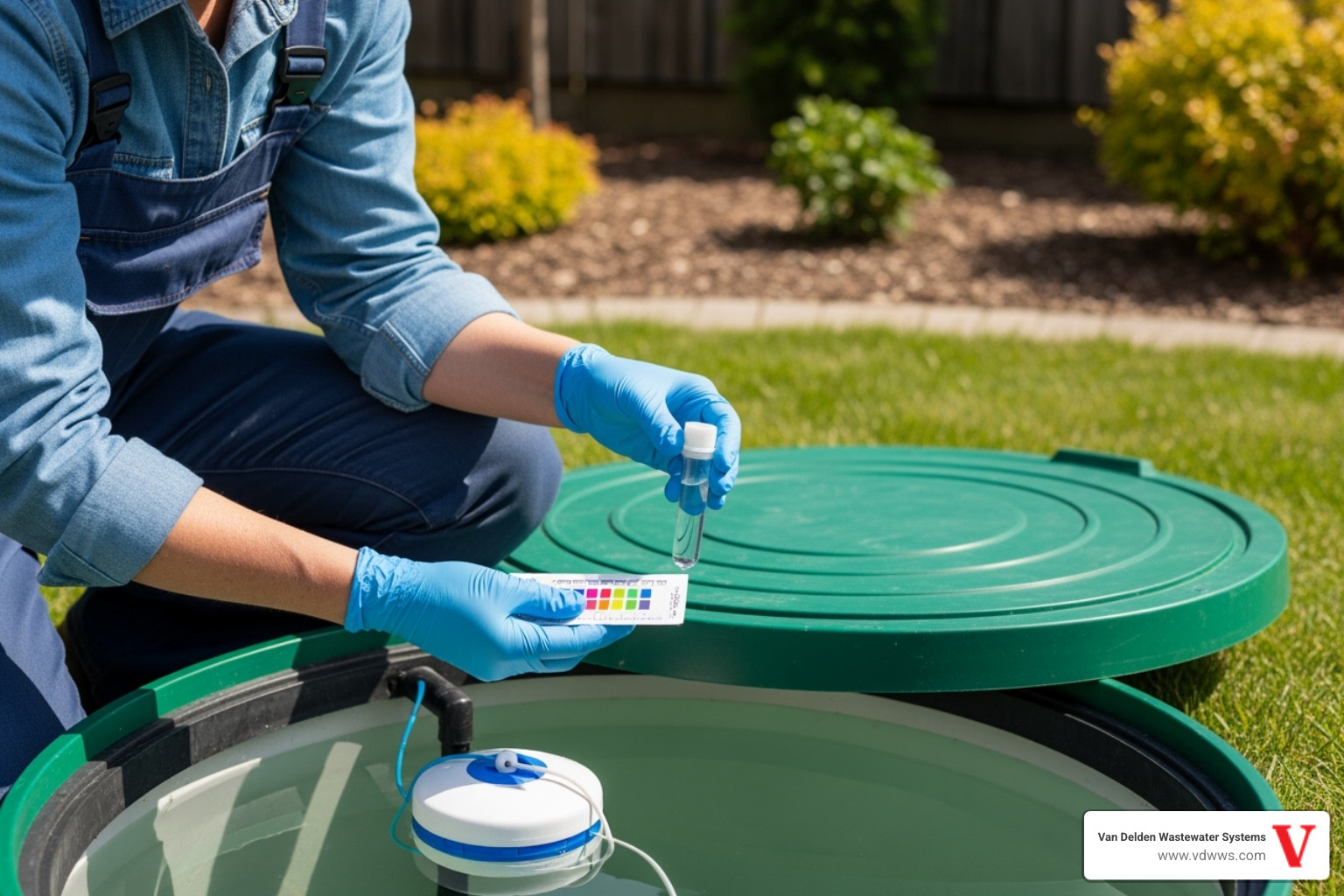
The pillars of care are water conservation, proper waste disposal, and drainfield protection. For a deeper dive, see our guide on Routine Maintenance for Aerobic Septic Systems.
The 'Dos and Don'ts' for a Healthy System
Most system failures trace back to simple mistakes. Here's what every aerobic system owner should know.
DO:
- Conserve Water: Space out laundry loads and fix leaky faucets and toilets. Reducing water usage gives your system time to properly treat wastewater. Our guide on How to Conserve Water to Keep Your Septic System Healthy has more tips.
- Get Regular Inspections: A licensed technician should check your system every four months to catch problems early.
- Fix Leaks Immediately: A running toilet or dripping faucet can constantly overload your system.
DON'T:
- Flush Anything But Waste and Toilet Paper: So-called "flushable" wipes, dental floss, and feminine products clog pipes and pumps.
- Use Harsh Chemicals: Bleach, drain cleaners, and antibacterial soaps kill the beneficial bacteria your system needs. Choose septic-safe products.
- Damage Your Drainfield: Never drive or park on the drainfield. Don't plant vegetable gardens or deep-rooted plants over it.
- Pour Fats, Oils, or Grease (FOG) Down the Drain: Scrape plates into the trash. FOG solidifies in pipes and tanks, causing blockages.
For a complete list, visit our Dos and Don'ts of Aerobic System Maintenance guide.
Water Usage and Waste: What Goes Down the Drain Matters
Everything that goes down your drains affects your system's health.
- Appliances: High-efficiency toilets and ENERGY STAR washing machines significantly reduce water usage. The EPA's WaterSense program helps identify water-saving fixtures.
- Garbage Disposals: These can increase solid waste in your tank by up to 50%, requiring more frequent pumping. If you use one, run plenty of water and avoid fibrous foods.
- Medications: Antibiotics and other drugs can kill beneficial bacteria. Use local take-back programs instead of flushing them.
Remember the golden rule: if it didn't come from your body or isn't toilet paper, don't flush it. Every good habit prevents costly aerobic system repair tomorrow.
The Professional Touch: When and Why to Call for Aerobic System Repair
While daily habits are key, aerobic systems are complex and require professional attention. In Texas, TCEQ regulations mandate regular inspections, and many counties require maintenance contracts with licensed providers. This isn't just red tape; it's your best protection against expensive aerobic system repair emergencies.

Professional technicians have specialized tools and training to spot early warnings, calibrate components, and handle electrical systems safely. Considering a full system replacement can cost tens of thousands of dollars, professional maintenance is a smart investment.
Professional Inspection and Pumping Schedules
Your aerobic system needs attention on a predictable schedule.
Inspection Frequency: TCEQ mandates inspections every four months. This is necessary because aerobic systems have many moving parts (pumps, aerators, controls) that can fail. During these visits, technicians follow a comprehensive checklist to ensure nothing is missed. See The 18 Items Your Aerobic Septic System Technician Should Be Checking.
Pumping Frequency: Pumping is typically needed every three to five years, depending on household size, water usage, and tank size. Pumping removes the sludge and scum that accumulate over time. If these layers get too thick, they can damage your drainfield. Learn more about Why You Should Have Your Aerobic System Cleaned.
The Long-Term Costs of Neglecting Aerobic System Repair
Skipping maintenance saves a little now but costs much more later. The consequences of neglect can be staggering:
- Premature System Failure: Components wear out faster without proper care.
- Drainfield Damage: This is the most expensive problem. Clogged drainfields can lead to wastewater surfacing in your yard and may require complete replacement.
- Environmental Contamination: Untreated wastewater can contaminate groundwater, creating public health hazards.
- Costly Replacement: A full aerobic system replacement can cost $20,000 to $40,000 or more.
- Property Value Decline: A failing septic system is a major red flag for potential buyers and can make a home difficult to sell.
- Health Hazards: Exposure to raw sewage can cause serious illness for your family and pets.
Regular maintenance and prompt aerobic system repair are the best ways to avoid these costs.
Frequently Asked Questions about Aerobic System Care
Here are concise answers to the most common questions we hear from homeowners.
How often should my aerobic system be inspected by a professional?
TCEQ mandates inspections every four months. This is more frequent than for conventional systems because aerobic systems have mechanical and electrical components (pumps, timers, floats) that require regular checks. These inspections catch small issues before they become major aerobic system repair projects and ensure you comply with local regulations.
What are the most critical things to AVOID putting in my aerobic system?
Your system contains beneficial bacteria that can be harmed or killed by certain items. Never put these down your drain:
- Harsh Chemicals: Bleach, drain cleaners, paint thinners, and pesticides.
- Non-Biodegradable Items: "Flushable" wipes, feminine hygiene products, dental floss, and diapers will cause clogs.
- Fats, Oils, and Grease (FOG): These solidify in pipes and tanks, causing blockages.
- Medications: Prescription drugs can harm the system's bacteria. Use a local take-back program.
- Excessive Garbage Disposal Use: This can increase the solid load in your tank by up to 50%, requiring more frequent pumping.
Can I fix my aerobic system myself when the alarm goes off?
There are a few basic steps you can take. First, check if the system's power switch is on and reset the breaker if it has tripped. Reduce your water usage immediately to prevent backups. You can also perform a quick visual check for obvious issues like clogged spray heads or standing water.
However, aerobic system repair involving electrical components, pumps, or internal parts requires professional expertise. Attempting complex repairs yourself is dangerous and can cause more damage. When in doubt, call a licensed professional to diagnose and fix the problem safely.
Conclusion: Protecting Your Investment with Proper Care
Your aerobic septic system is a significant investment in your home's infrastructure. When you understand how it works, recognize warning signs, and commit to proactive care, you ensure system longevity, practice environmental responsibility, and gain peace of mind.
Your system works 24/7 and deserves consistent attention. Regular inspections every four months, timely pumping, and mindful daily habits—like conserving water and avoiding harsh chemicals—are the best ways to prevent big, expensive problems. Catching issues early turns a major aerobic system repair into a simple fix.
Homeowners who accept routine care rarely face emergencies. Their systems run smoothly, their property value is protected, and they often see their systems last well beyond the expected lifespan.
While you can handle basic troubleshooting, complex repairs require professional expertise. The electrical components and sophisticated pumps in your aerobic system need trained hands when problems arise.
For expert aerobic system repair and maintenance, Van Delden Wastewater Systems is ready to help. As a family business serving Texas since 1937, we understand your septic system is vital to your home. Our experienced technicians provide the expertise and care to ensure your system runs smoothly for years to come.
Customer Reviews
Peter was personable, professional and thorough. Highly recommend Van Delden. You might be able to find a cheaper company but not better!
On time. 100% professional, knowledgeable, and courteous. Very helpful and straightforward. That is the bar all businesses should strive for.
It has been a pleasure working with your company. Not only did y’all communicate very well but your workers were always polite! Thank you!
“I thank Van Delden for such prompt service. Honest people are hard to come by these days. I will certainly recommend Van Delden to anyone! Jesse is an upstanding young man and very nice to talk to. I thank everyone at Van Delden for taking such good care of me.”
This is just a note to thank you for explaining the problem with my system. You didn’t have to be so kind and I appreciate your good business ethics and time spent. In the future you will have mine in return!



